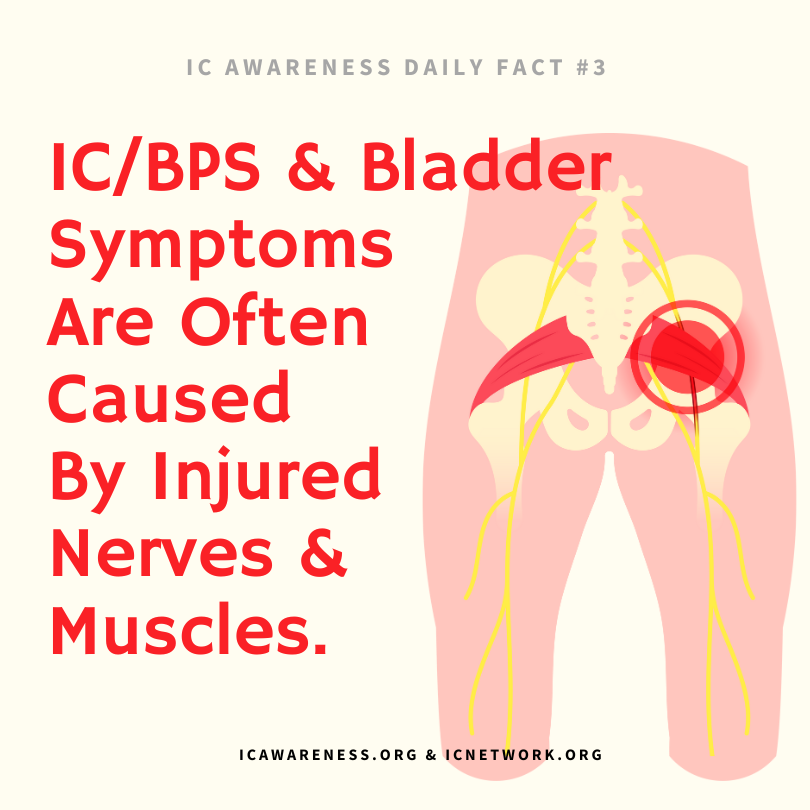TikTok Video
@icnetworkjill IC Awareness Daily Fact 3 – IC is a pelvic pain syndrome and for many of us, it’s not a bladder disease. #ictok #icawareness #pelvicpain ♬ original sound – IC Network
What’s New in Updated 2022 AUA Guidelines
In 2022, the American Urological Association revised their Guidelines for the Diagnosis and Treatment of IC that will help patients find the best treatments for their unique case of IC. AUA no longer considers IC a “bladder disease” but rather a “chronic pelvic pain syndrome.” Why? Because many patients have normal bladders and have other disorders outside of the bladder triggering their symptoms and pain.
The 2022 new guidelines acknowledge that there are (at least) three distinct patient groups, each with their own treatment priorities, including:
- Bladder Centric – Patients who have Hunner’s lesions, pain as the bladder fills with urine or smaller bladder capacity. This can also include patients who have estrogen atrophy (genitourinary syndrome of menopause) and chemo cystitis.
- Pelvic Floor Centric – Patients with tight, sensitive pelvic floor muscles.
- Chronic Overlapping Pain Conditions – These patients have multiple pain conditions, including: IC, IBS, vulvodynia, fibromyalgia, TMJ and others.
The treatments are no longer listed in six, ordered steps to give doctors the flexibility to provide specific treatments more promptly. For example, they recommend that all patients with tight, sensitive pelvic floor muscles be immediately referred to a pelvic floor physical therapist. Similarly, if Hunner’s lesions are found, they too should be treated immediately rather than waiting several months.
Should you expect your doctor to know about these treatment guidelines? No. Many doctors are unaware of this national standard and/or may be treating IC out of old text books. Please bring a copy of these guidelines with you for your doctor!
Treatment Approach
- No single treatment works over time for the majority of patients. Treatment should be tailored to the specific symptoms (phenotype/ subtype) of each patient.
- Pain Management is an integral part of IC therapy and should be assessed at every appointment and treated with a variety of therapies.
- If a patient is not responding to multiple treatments, the diagnosis of IC/BPS should be reconsidered. If bladder therapies are not effective and/or a patient is getting worse rather than better, the AUA strongly recommends reconsidering the diagnosis. Was something missed? Is another condition present that could be producing pelvic and/or urinary symptoms, such as: endometriosis, fibroid tumors, pelvic congestion syndrome, tarlov cyst, pudendal neuralgia or coccyx injury?
Self-help Strategies
- Water Intake
- Diet Modification
- Heat or Cold Therapy
- Self-Help
- OTC Supplements
- Meditation & Stress Management
- Muscle Relaxation & Guided Imagery
- Bladder Training
- Emotional Support
- Treat Other Pain Sources
- Avoid Known Triggers
AUA Strong Recommendations
Oral Therapy Options
Bladder Instillation Options
Procedures
- Hydrodistention
- Hunner’s Ulcer Treatment
- Neuromodulation – Urgent PC, Interstim
- Botulinum Toxin
Major Surgery
Other Therapies
- Antispasmodics – Ditropan, Oxytrol
- Anesthetics – Pyridium, AZO Bladder Pain Relief, Uribel
- OAB Medications – Detrol, Myrbetriq
Discontinued Therapies
- Long Term Antibiotics
- Bacillus Calmette Guerin (BCG)
- Resiniferatoxin (RTX)
- High Pressure Hydrodistention
- Long Term Glucocorticoids
- Silver Nitrate, Chlorpactic, Argyrol
Suggested Reading
-
Clemens JQ, Erickson DR, Varela NP et al: Diagnosis and treatment of interstitial cystitis/bladder pain syndrome. J Urol 2022. Read them here!
References for Professionals
- USA – AUA Guidelines – Provides an extensive review of the literature and related studies of the six step treatment plan discussed above.
- International – International Society for the Study of BPS (ESSIC) – Treatment guidelines and suggestions offered by an international organization of IC researchers and clinicians.
- Japan – Clinical guidelines for IC and hypersensitive bladder syndrome
- Bladder Pain Syndrome: A Guide for Clinicians (2012) – For Clinicians & Researchers


